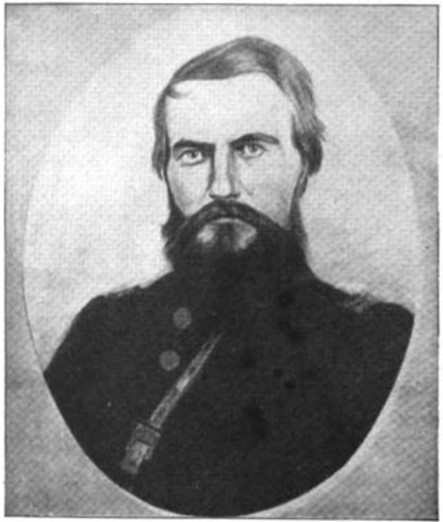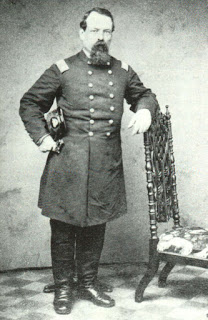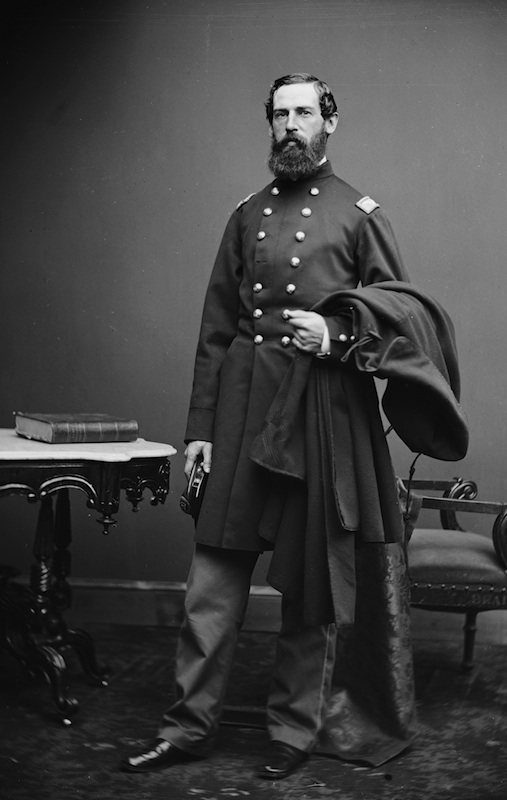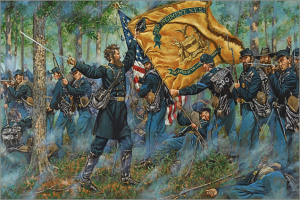Fallen New York Officers at the Deep Cut
At 3 p.m. on August 30, 1862, 10,000 Union soldiers charged across the Groveton-Sudley Road toward the Confederates occupying the stretch of an unfinished railroad around the Deep Cut. Of the seventeen regiments that participated in this assault led by Maj. Gen. Fitz John Porter, twelve hailed from New York. Three of those regiments, the 24th, 30th, and 80th (20th Militia) New York Infantry lost their commanding officers during the attack.
Porter’s attack against Stonewall Jackson’s Confederates in the Deep Cut has always been the most interesting action of the Battle of Second Manassas to me. Particularly, I have found the stories of these three men fascinating. Below are brief biographies of their lives but, as always, there is more to each of their stories.

Maj. Andrew Jackson Barney, 24th New York Infantry: Andrew Jackson Barney was 33 years old on August 30, 1862. This man with a martial name was born in Massachusetts but moved with his family to Belleville, New York. There, in 1851, the young Barney became acquainted with Thomas Jonathan Jackson. Barney’s father, a well-known dietary physician, offered Jackson the opportunity to stay at his home and recoup his health. Jackson gladly accepted and befriended the Barney family during his six weeks there.

When the Civil War began in 1861, Andrew Barney, by then a farmer, was the first man from Belleville to volunteer for the Union army. “He rose and said this country was dearer than life to him,” one eyewitness wrote, “and that he would be ready to start for Washington the next day.” Barney’s devotion to his country spurred him to raise Company K, 24th New York Infantry, of which the men elected him to be its captain. Before the end of 1861, Barney became the regiment’s major.
When Porter’s assault began on August 30, Maj. Barney led his troops forward mounted on horseback. “Forward, Twenty-fourth!” he screamed to begin the assault. Incredibly, Barney and his New Yorkers reached the railroad embankment relatively unscathed. At close range, they fired a volley into their enemy, which caused some wavering in the Confederate lines. Barney urged his men forward once again. He jumped his horse over a fence and rode it to the top of the embankment between the hostile lines. “Come on! Come on!” said Barney, trying desperately to carry the position. Even the Confederates admired the man’s courage. “Don’t kill him!” shouted some. However, a volley of musketry soon rang out from the Confederate lines. One bullet hit Barney’s head and he collapsed off his horse, which soon ran into enemy lines. For a moment, his limp body rested atop the embankment before a daring Confederate dragged him to cover. No matter though, for Barney only had hours to live.
Near the end of the action, captured Union soldiers carried Barney’s remains on a stretcher to the rear of Jackson’s line. There, Jackson recognized Barney’s face. Sorrow overcame the general. He ordered that Barney’s remains be respectfully treated by all who came across them and also that the body be returned to the Union army. At the first opportunity he had, Jackson wrote a letter to Barney’s father, who later retrieved his son’s remains and returned them to New York. They now rest in Woodside Cemetery in Belleville.
Col. Edward Frisby, 30th New York Infantry: Edward Frisby was born on August 3, 1809, in Trenton, New York, making him 53 years old at the time of his death. From an early age, “he evinced a great taste for a military life,” writes one of his biographers. At age 18, he became a corporal in the New York State Militia. By the end of his 33-year career in the Empire State’s militia, Frisby had been promoted to the rank of brigadier general. He retired in 1860 to spend time with his family. However, the next year, the war began. Frisby picked up his sword and raised the 30th New York Infantry.

Once in the army, Frisby exerted his militia experience over the men of his regiment. He drilled them incessantly, even on Sundays until orders from Army of the Potomac headquarters squashed the drilling of the regiment on the Sabbath.
Frisby did not forget his wife and children at home. In one letter, he told his wife, “It is hard for you to be left alone, but you must consider that the cause in which we are engaged requires sacrifices, and you are doing your duty as much as the soldier who is fighting upon the field of battle. If I can see this war honorably brought to a close, I shall not regret any sacrifice that I have made. I may not live to enjoy it, but I know that my boys will not love their country the less because their father fought for it.”
During Porter’s attack, Frisby’s 30th New York formed on Barney’s left. Both regiments occupied the front line of John Hatch’s division. The division commander rode up to Frisby just before the assault began and exclaimed, “Colonel Frisby! Take your men in there! The rebels are in there thicker than hell!” Frisby turned in his saddle, faced his men, and yelled, “Attention, men! Forward! Charge!”
Shortly after ordering his men into battle, one ball struck Frisby in the lower jaw, “passing through his face.” Despite the gruesome wound, Frisby remained mounted and continued forward. Major Morgan Chrysler approached the colonel and said, “Colonel, you are hit.” Frisby, with blood splattered across his face, retorted, “Major, to your post!” He drew his sword and continued leading his men. A few moments later, another bullet passed through Frisby’s head, killing him instantly.
The regiment’s subsequent withdrawal left Frisby’s remains on the battlefield, where a surgeon in the 22nd New York buried them, though not before a Confederate soldier took the colonel’s boots. That surgeon notified Maj. Chrysler of the location of Frisby’s burial once he made it back to Union lines. On September 9, Chrysler and one of Frisby’s old militia comrades retrieved the body. It was laid to rest in Albany Rural Cemetery on September 11, 1862.
Three days later, the 30th New York participated in the Battle of South Mountain. Before going into battle, Col. William Searing motivated his men by informing them, “Boys, the men who killed your Colonel at Manassas are now in front of you, let us charge and avenge his death!” (Whether or not Searing actually knew this or used this as a slick ploy to motivate his troops remains unclear. In any event, the Confederates the 30th New York fought at South Mountain were not the men who killed Col. Frisby.) In this battle, the Federals successfully drove the enemy from the field. Sorting through the battle’s aftermath, a lieutenant in the regiment found a dead Virginia officer wearing boots inscribed with, “Colonel Edward Frisby, 30th NYV.” The regiment sent the boots home to Mrs. Frisby.
Col. George W. Pratt, 20th New York State Militia: George Watson Pratt was born in the town of Prattsville, New York, on April 18, 1830, making him 32 years old in August 1862. His father Zadock founded the town to house the workers of the local tannery he founded, which at the time was the largest such operation in the world. Zadock Pratt also served in the United States House of Representatives.

George thus had big shoes to fill when he grew up and it appears that he did not disappoint. He worked as a merchant and later as a State Senator for New York. George was multilingual and led several prominent scientific societies in the United States and Europe (he even had an advanced degree from a German university). His library was described as “the best in the country.” It included copies of the Bible in 32 languages. However, none of this held him back when the war began. George Pratt was one of the first from his area to join the Union war effort and he quickly became colonel of the 20th New York State Militia (N. Y. S. M.).
The 20th N. Y. S. M. did not participate in the first wave of Porter’s assault. But as the main attack bogged down in front of the railroad cut, Confederates began to enfilade the right flank of the attacking force. Brigade commander Marsena Patrick witnessed this event from his reserve position and ordered Pratt’s regiment into the fight to protect the right flank units, including the 24th New York.
Pratt’s men moved through woods instead of open fields like the rest of Porter’s men. Pratt, also mounted, rode in front of his men, shouting to them, “If there are any sick men here let them fall out now!” None did, and the regiment continued forward. The terrain led Pratt’s command too far to the right. Likely while in the process of trying to figure out where he was supposed to be and who he was supposed to be supporting, Pratt, standing dismounted near the left of his regiment, suddenly became “paralyzed by the concussion of a cannon ball,” noted the Albany Evening Journal. Strangely, the wound “left no outward marks of injury.” Pratt made it home to Albany but died of his wound on September 11, 1862. He was buried in Albany Rural Cemetery.

Of these three officers, Pratt is the only one to have a personal monument erected–or carved–in his honor. His father Zadock donated the Monument Hill portion of his land to the townspeople of Prattsville in 1843. Then, Zadock Pratt contracted with several stonecutters to carve symbols of his life and family into the rock. When his son George died, Zadock had a mural of his son carved into the mountainside with an inscription underneath it that reads: “Hon. G.W.Pratt, Ph.D.COLXX Regt., N.Y.S.M., Ulster Co., BORN APR. 18 1830 WOUNDED AUG. 30, IN THE 2ND BATTLE OF MANASSAS, VA. DIED AT ALBANY, N.Y. SEP. 11TH GOOD BRAVE HONORABLE 1862.” This monument, still carved into Pratt Rock as it is now known, is one of the country’s earliest Civil War monuments and memorials. Today, Pratt Rock has been called “America’s first Mount Rushmore.”

Nice post Kevin – thank yor for highlighting the storys of these three fallen NY commanders.
Thanks for reading, Blake.
Loved this thank you for putting this together
Excellent tribute.
Thanks, Chris.
Thanks for a “shout out” about a battle that gets little scholarly attention and a remembrance to three New York officers who, while generally from locally prominent families, were the very antithesis of privilege.
Thank you for reading!
Thank you for writing. It was a good piece. I enjoyed it.
This is a well-done piece about a fight that still – despite Hennessy’s and Patchan’s work – just doesn’t get enough attention.
Agreed, John. It’s the largest Union attack of the battle and is vastly overshadowed by what happens right after it.
Hi Kevin,
Great work on these mini-bios. I had not heard before the story of Stonewall Jackson knowing the Barney family.
I had heard the story of Frisby’s boots/South Mountain and was always a little skeptical, especially since the 30th NY (Walter Phelps’s brigade) opposed Longstreet’s Wing at South Mountain, specifically Garnett’s and Evans’s brigades, which did not fight at the Deep Cut and would not have an opportunity to pilfer from the dead of the 30th NY at Second Manassas.
If there is any truth to the story, I wonder if the writer meant Antietam, not South Mountain. The 30th NY fought in the Cornfield and opposed the Stonewall Division there, including the same Virginia regiments that the 30th NY fought at the Deep Cut.
Good stuff,
Todd
Hi Todd,
Thanks for reading. Regarding the story of Frisby’s boots, I believe the author was definitely correct in stating that it was at South Mountain. However, there was no way the officer could have known who they were fighting, so I think he was saying it just to motivate his men. Then, they happened to stumble upon Frisby’s boots, making it all the better of a story.
Hi, Kevin
Would you give us permission to post your excellent article on the Town of Prattsville website? Thank you for writing this article, especially your portrayal of George Pratt. Best, Carolyn Bennett, Prattsville Town Historian and former Executive Director, Zadock Pratt Museum.